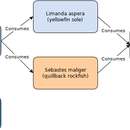en
names in breadcrumbs


Pleuronectidae, also known as righteye flounders, are a family of flounders. They are called "righteye flounders" because most species lie on the sea bottom on their left sides, with both eyes on their right sides.[1] The Paralichthyidae are the opposite, with their eyes on the left side. A small number of species in Pleuronectidae can also have their eyes on the left side, notably the members of the genus Platichthys.[2][3]
Their dorsal and anal fins are long and continuous, with the dorsal fin extending forward onto the head. Females lay eggs that float in mid-water until the larvae develop, and they sink to the bottom.[4]
They are found on the bottoms of oceans around the world, with some species, such as the Atlantic halibut, Hippoglossus hippoglossus, being found down to 2,000 m (6,600 ft). The smaller species eat sea-floor invertebrates such as polychaetes and crustaceans, but the larger righteye flounders, such as H. hippoglossus, which grows up to 4.7 m (15 ft) in length,[5] feed on other fishes and cephalopods, as well.
They include many important commercially fished species, including not only the various fish called flounders, but also the European plaice, the halibuts, the lemon sole, the common dab, the Pacific Dover sole, and the flukes.
The name of the family is derived from the Greek πλευρά (pleura), meaning "rib" or "side", and νηκτόν (nekton), meaning "swimming".
The family has four subfamilies:
In some classifications, the last three subfamilies are raised to the level of families.[6][7]
Atlantic halibut, Hippoglossus hippoglossus
Greenland halibut, Reinhardtius hippoglossoides
American plaice, H. platessoides
Witch, Glyptocephalus cynoglossus
Lemon sole, Microstomus kitt
Common dab, Limanda limanda
English sole, Parophrys vetulus
Pacific sand sole, Psettichthys melanostictus
Deepwater dab, Poecilopsetta beanii
Black flounder, Rhombosolea retiaria
{{cite web}}: CS1 maint: others (link) Pleuronectidae, also known as righteye flounders, are a family of flounders. They are called "righteye flounders" because most species lie on the sea bottom on their left sides, with both eyes on their right sides. The Paralichthyidae are the opposite, with their eyes on the left side. A small number of species in Pleuronectidae can also have their eyes on the left side, notably the members of the genus Platichthys.
Their dorsal and anal fins are long and continuous, with the dorsal fin extending forward onto the head. Females lay eggs that float in mid-water until the larvae develop, and they sink to the bottom.
They are found on the bottoms of oceans around the world, with some species, such as the Atlantic halibut, Hippoglossus hippoglossus, being found down to 2,000 m (6,600 ft). The smaller species eat sea-floor invertebrates such as polychaetes and crustaceans, but the larger righteye flounders, such as H. hippoglossus, which grows up to 4.7 m (15 ft) in length, feed on other fishes and cephalopods, as well.
They include many important commercially fished species, including not only the various fish called flounders, but also the European plaice, the halibuts, the lemon sole, the common dab, the Pacific Dover sole, and the flukes.
The name of the family is derived from the Greek πλευρά (pleura), meaning "rib" or "side", and νηκτόν (nekton), meaning "swimming".